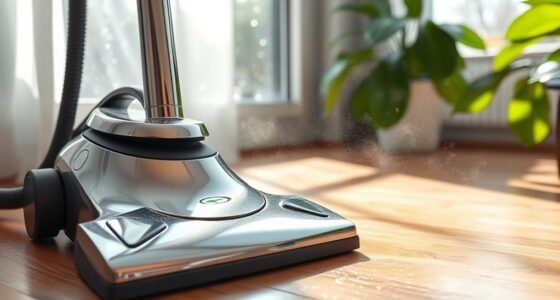To control clutter and minimize dust and allergen traps, start by regularly sorting and decluttering your space. Use practical storage solutions like clear bins, shelves, and drawers to keep belongings organized and surfaces clear. Avoid ornate furniture with intricate carvings that trap dust, and opt for easy-to-clean materials. Keep air purifiers and vacuum often to remove airborne dust. Maintaining a tidy environment helps improve indoor air quality; discover more tips to keep your space clean and healthy.
Key Takeaways
- Regularly declutter and donate unnecessary items to reduce dust traps and allergens.
- Use clear, airtight storage containers to keep dust out of stored belongings.
- Create designated zones for different items to prevent clutter spread and facilitate cleaning.
- Opt for smooth-surface furniture and washable storage solutions to make dust removal easier.
- Vacuum frequently and use air purifiers to minimize airborne dust and allergens in the environment.

Have you ever felt overwhelmed by clutter in your home or workspace? It’s a common experience, and it often leads to dust buildup and increased allergens, making your environment less healthy. The key to controlling clutter and minimizing dust traps lies in effective storage solutions and decluttering strategies. When you organize your space thoughtfully, you not only create a visually appealing environment but also reduce the surfaces where dust and allergens can settle.
Start by evaluating your current space and identifying areas prone to accumulating clutter. Use storage solutions that are practical and accessible, such as bins, shelves, and drawers. Clear containers with lids are excellent for keeping dust out of your belongings, especially when storing seasonal items or seldom-used objects. Vertical storage options can maximize space and keep surfaces clear, making it easier to maintain cleanliness. When choosing storage solutions, prioritize items that fit your lifestyle and specific needs, ensuring you’re more likely to keep your space tidy.
Evaluate your space, choose practical storage like bins and shelves, and prioritize items that fit your needs.
Implementing decluttering strategies is equally important. Begin by sorting through your belongings and setting aside items you no longer need or use. Be honest with yourself—if an item doesn’t serve a purpose or bring you joy, consider donating or discarding it. As you declutter, make sure to clean the surfaces thoroughly, including shelves, drawers, and hidden corners where dust can silently settle. Regularly scheduled decluttering sessions prevent accumulation of unnecessary items, which often become dust traps over time.
Another effective approach involves creating designated zones for different categories of items. For example, keep cleaning supplies in one area, paperwork in another, and personal items in a different section. This organization reduces chaos and makes it easier to tidy up quickly, preventing clutter from spreading and dust from settling in cluttered spaces. Don’t forget to assign a specific place for everything. When items have a home, you’re less likely to leave them out, reducing clutter and making cleaning easier.
Additionally, consider the materials of your storage furniture. Opt for smooth surfaces that are easy to wipe down, and avoid overly ornate furniture with intricate carvings where dust can hide. Using air purifiers and vacuuming regularly also helps capture airborne allergens and dust that settle in hidden corners. Maintaining a clean, clutter-free environment requires ongoing effort, but with the right storage solutions and decluttering strategies, you create a space that’s healthier and easier to keep dust and allergens at bay. Remember, a tidy environment isn’t just visually appealing—it actively contributes to better indoor air quality and your overall well-being. Incorporating home theatre projectors with high contrast ratios can significantly improve your viewing experience in a clutter-free space.
Frequently Asked Questions
How Often Should I Replace Air Filters to Reduce Dust Buildup?
You should replace your air filter every 1 to 3 months, depending on its lifespan and allergen filtration efficiency. Regular changes guarantee the filter continues effectively capturing dust and allergens, maintaining good indoor air quality. If you have pets or allergies, consider replacing it closer to the 1-month mark. Check the manufacturer’s recommendations and inspect the filter monthly to prevent clogging, which reduces filtration efficiency.
What Are the Best Materials to Prevent Dust Accumulation on Surfaces?
Think of your surfaces as smooth, sturdy boats sailing through a dust storm. To prevent dust buildup, choose materials with high durability and smoothness, like sealed hardwood or glass. These surfaces resist dust adherence better than porous or textured ones, making cleaning easier. Regularly wipe them with a damp cloth to keep dust from settling. Your goal is to create a barrier that’s both sleek and resilient against the relentless dust waves.
Can Indoor Plants Help Reduce Dust and Allergens Effectively?
Indoor plants can help reduce dust and allergens through their plant benefits and natural air purification. By trapping airborne particles on their leaves and roots, they improve air quality and decrease dust buildup. Choose plants like spider plants or peace lilies, which are known for their air-purifying qualities. Regularly cleaning your plants and keeping them healthy guarantees they continue to contribute to a cleaner, allergen-reduced environment indoors.
Are There Specific Cleaning Tools Recommended for Allergen Control?
Yes, using electrostatic dusters and HEPA vacuum cleaners is highly recommended for allergen control. Electrostatic dusters attract and trap dust and allergens effectively, making dusting quicker and more thorough. HEPA vacuum cleaners filter out tiny particles from carpets, upholstery, and floors, reducing allergens in your home. Regular use of these tools helps keep your environment cleaner, healthier, and free from triggers that can worsen allergies or asthma symptoms.
How Does Humidity Level Affect Dust and Allergen Retention Indoors?
Have you noticed how dust settles more quickly in dry air? Humidity impact is significant; when humidity is too high, dust and allergens cling to surfaces, increasing retention. Conversely, low humidity can dry out mold spores, reducing mold growth but causing dust to become airborne more easily. Maintaining indoor humidity around 40-50% helps minimize dust and allergen buildup while preventing mold issues, creating a healthier environment.
Conclusion
By keeping clutter at bay, you clear the path for cleaner air and healthier living. Think of clutter as a magnet for dust and allergens—removing it is like pulling the plug on their hideout. Stay organized, regularly tidy up, and your home will become a fortress against dust and allergens. Remember, a clutter-free space isn’t just neat; it’s a breath of fresh breeze that keeps your environment safe and comfortable. Take control and breathe easier today.









